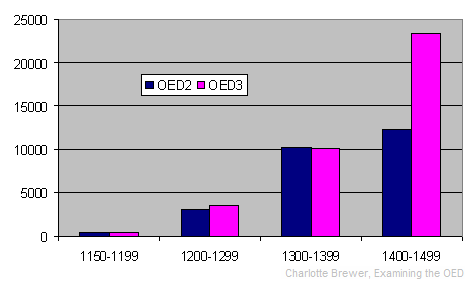1150-1499 is the period we can expect to change most significantly in the new version of
OED. For reasons outlined in our page on the
medieval portion of their
period coverage, the original
OED lexicographers, working with very restricted access to texts from this earlier stage of the language, were simply unable to do justice to Middle English. Now, however, the revisers at work on
OED3 are able to draw on a wide range of subsequently published texts and scholarship, together with the resources of the
Toronto Old English Dictionary project (ongoing), the
Dictionary of the Older Scottish Tongue (compiled 1937-2002)
, and, especially, the
Michigan Middle English Dictionary (compiled 1952-2001). The last two projects covered vast amounts of material untapped by the first edition of
OED (all three were projected by W. A. Craigie, one of the original
OED lexicographers, in 1919: see
Craigie 1919).
As the Deputy-Editor of
OED3, Edmund Weiner, wrote in 2000, 'no extensive reading programme [for the current revision of
OED] has been undertaken for Middle English, though certain newly available texts are being read,' since 'in this sphere the
OED has to bow to the primacy of the
MED, and, to a more limited extent, the
DOST,' who have between them 'already assembled the overwhelming majority of the available lexical evidence. The main effort of the
OED project is concentrated on a painstaking comparison between the coverage of each word in these two dictionaries and the corresponding entries in the
OED' (
Weiner 2000a: 170; he later refers to this as a policy of 'limited but targeted data collection' (p. 172). On the 'inter-indebtedness' of historical dictionaries, see further
Simpson 2004a).
What are the results so far? To get a broad picture of the changes which the current revision of
OED has introduced into the quotation record, we need to isolate the portion of the alphabet range so far revised, and compare the number of quotations in
OED2 and
OED3 for this stretch of the alphabet only.
As of December 2005, the new revision, which started at the letter 'M' in 2000, had got mid-way through the letter 'P', up to the word 'philandering'. The table below compares the number of quotations in
OED2 and
OED3 over the alphabet range
M-philandering:
OED2 and OED3 quotations per decade 1150-1499 (M-philandering)
These results need further investigation, but it is clear that the
OED3 revisers have concentrated their efforts so far on the later medieval period (1400-1499). This may more easily be seen in our second table below and is probably to be explained by their heavy reliance on the
MED's documentation:
OED2 and OED3 quotations per century 1150-1499 (M-philandering)
The raw figures for total quotations
M-philandering over the period 1150-1499 are 26,086 for
OED2, and 37,291 for
OED3, making a notable (43%) increase of
11,205 quotations overall.
There have also been some major shifts in dating. As observed in our page on
Initial results: 1150-1499, the small number of texts available for this period when the first
OED was compiled, plus the difficulty of dating them accurately, led to bunchings of quotations at 'round number' dates (e.g. 1200 and 1300). Now that further scholarship on major sources such as the works of the
Gawain-poet has resulted in re-dating, large numbers of quotations in
OED2, though retained in
OED3, occupy a different place in
OED on our graph.
Thus three of the works of the
Gawain-poet, viz.
Pearl,
Patience, and
Cleanness, were quoted from Richard Morris's edition of 1864 (the first volume in the Early English Text Society created partly in order to provide printed quotation material from hitherto unpublished medieval sources for
OED), under the title
Early English Alliterative Poems (abbreviated 'E.E. Allit. P.'). They were dated '
c1325' in
OED1. Now, in
OED3 (i.e. over the alphabet range so far revised), they are identified by individual title (
Pearl,
Patience,
Cleanness) and dated '
c1400 (?
c1380)'.
Collectively (i.e. over the whole alphabet), quotations from this group of poems have risen from 2,552 in
OED2 to 2,587 in
OED3, an increase of only 35,
[1] indicating that these poems were very carefully read and excerpted by the first lexicographers, leaving little else for their successors to glean further. However,
OED3 has substantially increased quotations from other sources, on which we will report in more detail in due course.
Footnote
[1] Counted 16 June 2006, thus including
OED3's revision from
M to
pleating.